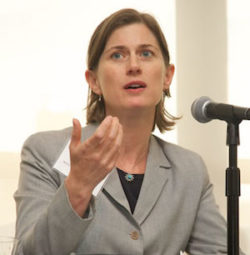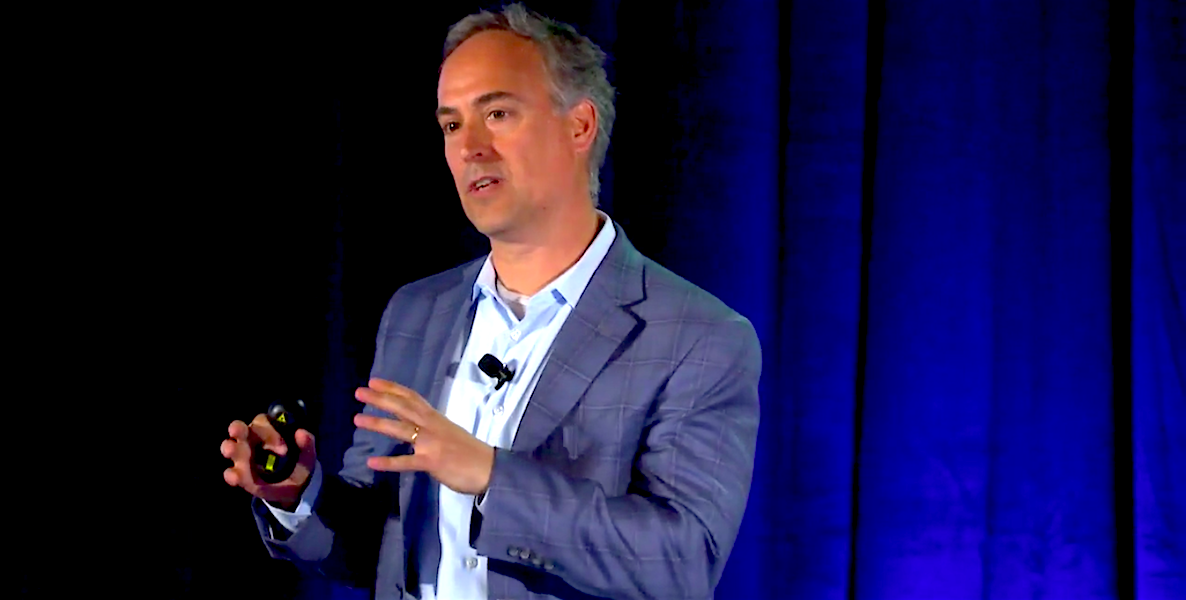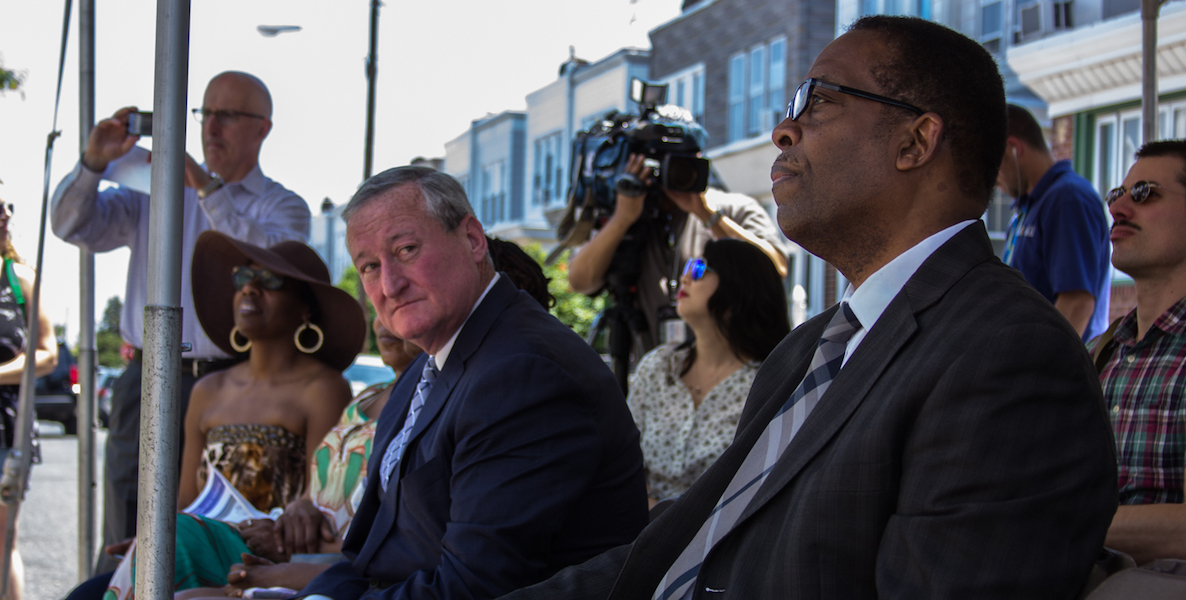In the Groundhog Day atmosphere of Philadelphia public life, it sometimes feels like a 26 percent poverty rate—the nation’s worst—is simply a given. An immutable fact of local life. Once in a while, we get jolted awake that it needn’t be like this. Sometimes a mayoral candidate will come along, as Jim Kenney did three years ago, and remind us that the percentage among us who subsist daily below the poverty line—under $20,000 a year for an adult with two children—is “shameful” and “an embarrassment.” Sometimes, a dynamic civic leader like Paul Levy, President of Center City District and our leading apostle of economic growth, will remind us that “Poverty is not a scourge like a biblical plague. It is neither fate, nor a fact-of-life.”
When that happens, when the rhetoric of public officials rises to the moment, when it is informed by urgency and inspirational spirit, it underscores a fundamental truth: There is actually no reason that the birthplace of American democracy ought to be in last place when it comes to the economic security of its citizens.
 But that happens only rarely. Mostly, our poverty story is about a plodding bureaucracy that, unaccountable, simply marches on, as evidenced most recently by reports looking at the amount of spending with hardly any results of City Hall’s anti-poverty office, the Office of Community Empowerment.
But that happens only rarely. Mostly, our poverty story is about a plodding bureaucracy that, unaccountable, simply marches on, as evidenced most recently by reports looking at the amount of spending with hardly any results of City Hall’s anti-poverty office, the Office of Community Empowerment.
I’ve written before about New York’s stunning turnaround on poverty under Mayor Michael Bloomberg. Between 2000 and 2013, the poverty rate in America’s 20 largest cities grew by 36 percent, to an average of 22.7 percent. But there’s been one stand-out exception: New York City, where the poverty rate declined by 4 percent between 2006 and 2013. Today, New York has a smaller share of poverty than Los Angeles, Chicago, Phoenix and Houston, among others.
This didn’t just happen. It was the result of an innovative, data-driven war on poverty declared in 2005 by Bloomberg and his deputy mayor, Linda Gibbs, which was nothing short of a revolution in the way government approaches poverty. And it’s an approach still being undertaken today, albeit under a different name, by Bloomberg’s successor, Bill DeBlasio.

First, a bit of background. Back in 2005, Bloomberg named Geoffrey Canada, the entrepreneurial founder of the groundbreaking Harlem Children’s Zone charter school, and Dick Parsons, the former CEO of Time Warner, to head the Commission for Equal Opportunity. Their 2006 report, “Increasing Opportunity and Reducing Poverty in New York City,” was a call for urgent action. It led to the Center for Economic Opportunity—in the Mayor’s office, critically—a driver of new ways to think about confronting poverty, with an emphasis on innovation and rigorous accountability.
Earlier this week, I caught up with its former executive director, Kristin Morse, who is now the Director of the Center for New York City Affairs at the New School. What follows is an edited and condensed version of our conversation, one with all sorts of object lessons for Philadelphia if our leaders want to do more than pay lip service to our most intractable problem.
LP: So, let’s begin with a fairly broad question. How’d you do it? How is it that New York is pretty much alone among major cities in having lowered the poverty rate over the last 10 to 15 years?
KM: Well, it was very incremental. In more recent years, higher employment participation and a higher minimum wage had a lot to do with it. Those things really matter. But you’re right—we did a lot of things no one else was doing to move the needle.
LP: Like what?
![]()
KM: Early on, Mayor Bloomberg and Linda Gibbs created a commission of business and civic leaders that came back and identified one of the problems to be the way we measure poverty. The way we do it federally is way too simple if the goal is to accurately reflect poverty. We’d say to the Mayor, “We’re going to enact this child care tax credit,” and he’d say, “Great. How much will that reduce the poverty rate?” And the answer was that it wouldn’t, because the calculations didn’t consider tax or in-kind benefits. Nor did they adjust for cost of living differences, or take into account income and expenses.
LP: If, say, cost of living been included in the calculations, New York would have had more people considered to be impoverished, right?
KM: Exactly. This is where the Bloomberg bravery came in. Because we came up with our own poverty measure, based on a model developed by the National Academy of Sciences which has since gone on to be adopted by the Census Bureau as a supplemental poverty measure. But that meant going to to the Mayor and saying our new measurement is going to make the problem look worse—the first thing we’re going to do out of the gate as part of your big poverty initiative is make us look like we’re in worse shape than people think. And he didn’t even flinch. “Go for it,” he said.
The whole idea was to invest in human capital so people can earn a decent living. With that as the focus, you had to have business at the table.
LP: My understanding is that CEO was a type of internal driver of experimentation within city government, that you’d work with agencies to test new approaches, while rigorously evaluating the results in order to scale up what works and discontinue what doesn’t. Did I read that you terminated 20 percent of your own programs?
KM: Yes. We had a $100 million per year innovation fund, made up of public and private resources, that was a real call to action within city agencies—agencies you wouldn’t think of as being critical to fighting poverty. The Finance Department came up with the idea to send out to taxpayers forms that were already filled out for them to claim from the federal government their Earned Income Tax Credits. Who would have thought that the Finance Department would be these anti-poverty warriors?
![]()
So, working with agencies, we’d launch pilot programs. Some continue to this day. Others—about 20 percent—either didn’t work or didn’t work to the extent we wanted them to, so the idea was to fail fast, and move on to the next idea. Our mandate was to take risks on new ideas, measure our results, hold ourselves accountable, and not to be afraid to try something else.
LP: Do you have one case study of an effective policy intervention that you’re particularly proud of?
KM: Absolutely. The City University of New York Accelerated Study in Associate Program (ASAP) more than doubled the community college graduation rate, and has since been duplicated in other cities. The CUNY Chancellor came to us and said, “These six things keep getting in the way of students earning their Associates degree—let’s design a program that gets them across the finish line.” So it turns out it was mostly a lot of practical stuff. Like, scheduling courses in blocks. Many community college students work, so if they know their classes will be Monday, Wednesday and Friday from 9 until noon, they can knock their classes out and regularly be on the job.
An important piece of it was identifying those handful of majors where an Associates degree could get you a decent job, and then making sure advisors are there to help steer students toward that path. Some of it was simple economic stuff. ASAP paid the tuition, but it turned out it was just as important to get metro cards in the hands of students. If you don’t have two bucks on you for the subway, you won’t make it to class. I can’t tell you how many kids drop out because they don’t consistently have subway fare.
It was a lot of pragmatic interventions, but the key was they have to all be done at the same time. And the result was a doubling of the graduation rate, which was unheard of.
Remember, we had the power of the Mayor behind us and the ability to work across all entities of the government. And when there was a department that didn’t have an interest in doing something innovative, we’d just take our dollars and our energy to the next department.
LP: How critical was the private sector to moving the needle in your experience?
KW: It was really important. The whole idea was to invest in human capital so people can earn a decent living. With that as the focus, you had to have business at the table. The city’s workforce development system was, first, one where very few people got jobs, and then people were getting jobs—but not particularly good ones. We pivoted to a third iteration, where people got jobs they wouldn’t otherwise get, by opening doors for them in the labor market and training for good jobs and, again, by incentivizing new ideas. We gave the city’s employment services agency approximately $7 million a year to test new ideas that they felt would ultimately yield better results but that might not satisfy the quick job placement requirements mandated by other public funding. Within a fairly short time period they were demonstrating a higher volume of better employment outcomes and could better use of their federal funding, in addition to our innovation dollars. I think this is a good example because it shows how innovative pilots can and should lead to systems change.
LP: It sounds like a big part of CEO’s mandate was to take on and change the glacial pace of government bureaucracy. Wasn’t it difficult confronting typical “slow walk” governmental culture?
KM: Remember, CEO was, and still is, part of the Mayor’s office. So we had the power of the Mayor behind us and the ability to work across all entities of the government. And when there was a department that didn’t have an interest in doing something innovative, we’d just take our dollars and our energy to the next department.
![]()
LP: Franklin Roosevelt once said “Do something. If it works, do more of it. If it doesn’t, do something else.” I think government has gotten afraid to try things. You tried some controversial ideas. Tell me about the Conditional Cash Transfer program.
KM: Yes, that was the most controversial. We were funded by a mix of public and private dollars, so we used private philanthropic money for the most risky ideas, and taxpayer money for the pilot programs and bringing them to scale. We partnered with philanthropies on the Conditional Cash Transfers, which involved subsidies for positive social behavior. That could mean paying families when a parent gets a job, or when a child does well in school, or even when taking a child to the dentist twice a year. The right and the left both hated it. The right said, “You’re giving people money for things they should be doing anyway.” And the left said, “You’re trying to change individual behavior rather than focusing on a more systemic problem.”
Well, I can waltz out of work to take my kid to the dentist, but if you’re an hourly worker, you get docked. This was an attempt to use cash as a nudge to influence behavior. It had mixed results. Among its successes, families actively participated and earned an extra $2,000 to $3,000 a year, and were less likely to self-report as food insecure. Where it came up short was it didn’t dramatically increase work. One of the ideas we had since was that maybe it should have been done more in conjunction with case management.
But actually, conditional cash transfers aren’t that rare. That’s what welfare has become, with its work requirements. Everything we did was an effort to make work pay. Mayor Bloomberg used to say that you shouldn’t get up at 6 am, go to work, and still live in poverty. So we’d always ask, how can we reward work? That’s what Paycheck Plus was all about.
LP: Was that extending the Earned Income Tax Credit to workers with no dependent children?
KM: Yes, it put an extra $1,400 a year in people’s pockets. Remember, we’re in the midst of 40 years of wage stagnation, so government has to ask, what can we do to make sure those who work are economically stable?
LP: Kristin, this has been very enlightening and I’d love to bring you to Philadelphia for a public discussion about some of these ideas. My head starts to hurt after a while thinking about the daunting challenges of poverty, but one thing I know is that if you only do what you’ve always done, you’re going to get what you’ve always gotten. So I love your willingness to try new ideas. Would you be open to a visit?
KM: Absolutely. Thanks so much.
Photo courtesy Allef Vinicius / Unsplash






